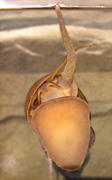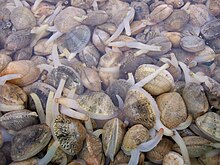Siphon (mollusc)


A siphon is an anatomical structure which is part of the body of aquatic
and relatives).Siphons in molluscs are tube-like structures in which water (or, more rarely, air) flows. The water flow is used for one or more purposes such as
A single siphon occurs in some gastropods. In those bivalves which have siphons, the siphons are paired. In

In gastropods
In some (but not all)
This siphon is a soft fleshy tube-like structure equipped with
Although in gastropods the siphon functions perfectly well as a tube, it is not in fact a hollow organ, it is simply a flap of the mantle that is rolled into the shape of a tube.[1]
In many marine gastropods where the siphon is particularly long, the structure of the shell has been modified in order to house and protect the soft tissue of the siphon. This shell modification is known as the siphonal canal. For a gastropod whose shell has an exceptionally long siphonal canal, see Venus comb murex.
In the case of some other marine gastropod shells, such as the volute and the Nassarius pictured to the right, the shell has a simple "siphonal notch" at the anterior edge of the aperture instead of a long siphonal canal.
The Aplysia gill and siphon withdrawal reflex is a defensive reflex which is found in sea hares of the genus Aplysia; this reflex has been much studied in neuroscience.
Siphon as a snorkel


Freshwater
Apple snails use the siphon in a way that is reminiscent of a human swimmer using a snorkel, except that the apple snail's siphon can be retracted completely, or extended to various lengths as needed.[6]
For these freshwater snails, the siphon is an anti-predator adaptation. It reduces their vulnerability to being attacked and eaten by birds because it enables the apple snails to breathe without having to come all the way up to the surface, where they are easily visible to predators.[6]
The shells of these freshwater snails have simple round apertures; there is no special notch for the siphon.
Paired siphons of bivalves


Those bivalves that have siphons, have two of them. Not all bivalves have siphons however: those that live on or above the substrate, as is the case in scallops, oysters, etc., do not need them. Only those bivalves that burrow in sediment, and live buried in the sediment, need to use these tube-like structures. The function of these siphons is to reach up to the surface of the sediment, so that the animal is able to respire, feed, and excrete, and also to reproduce.[7][8]
The deeper a bivalve species lives in the sediment, the longer its siphons are. Bivalves which have extremely long siphons, like the
Many bivalves that have siphons can withdraw them completely into the shell when needed, but this is not true of all species. Bivalves that can withdraw the siphons into the shell have a "pallial sinus", a sort of pocket, into which the siphons can fit when they are withdrawn, so that the two shell valves can close properly. The existence of this pocket shows even in an empty shell, as a visible indentation in the pallial line, a line which runs along parallel to the ventral margin of the shell.[10]
The bivalve's two siphons are situated at the posterior edge of the
Feeding
Depending on the species and family concerned, some bivalves utilize their inhalant siphon like the hose of a vacuum cleaner, and actively suck up food particles from the marine substrate. Most other bivalves ingest microscopic phytoplankton as food from the general water supply, which enters via the inhalant siphon and reaches the mouth after passing over the gill.[13]
Please also see pseudofeces.
Hyponome of cephalopods

The hyponome or siphon is the organ used by cephalopods to expel water, a function that produces a locomotive force. The hyponome developed from the foot of the molluscan ancestor.[14]
Water enters the mantle cavity around the sides of the funnel, and subsequent contraction of the hyponome expands and then contracts, expelling a jet of water.
In most cephalopods, such as
References
- ^ a b Örstan A. 13 April 2007. Melongena's siphon. Snail's Tales.
- ISBN 978-1-58238-125-1Nassa mud snails, p. 142.
- ^ Cone snails Archived 25 May 2011 at the Wayback Machine. Hawaiian Marine Life. Accessed 18 November 2008.
- ^ Respiratory system. The apple snail website. Accessed 18 November 2008.
- ^ Los Marineros Marine Life. Caption Mollusca. Archived 3 October 2000 at the Wayback Machine Accessed 21 November 2008.
- ^ a b c Respiratory system. The apple snail website, http://www.applesnail.net, accessed 26 February 2009.
- ISBN 978-1-57233-561-5. p. 66.
- ISBN 978-1-4200-6574-9. p. 77.
- ^ Washington Department of Fish and Wildlife. 2000. WDFW - Shellfish: Geoduck clam. accessed 26 February 2009.
- ^ M. Alan Kazlev. Palaeos Metazoa: Mollusca: Bivalvia: Bivalve Glossary Archived 6 November 2008 at the Wayback Machine. Page uploaded 11 January 2003, last change 7 July 2007, accessed 26 February 2009.
- ^ Anatomy of a Bivalve Archived 23 April 2009 at the Wayback Machine. accessed 26 February 2009.
- ^ Siphons Archived 12 March 2008 at the Wayback Machine. accessed 26 February 2009.
- ISBN 0-7137-0698-8, pp. 288, page 8.
- ^ Class Cephalopoda: the Head-Feet Archived 16 September 2008 at the Wayback Machine Accessed 21 November 2008.
- ^ Discussion. http://palaeo-electronica.org/ Accessed 21 November 2008.
External links



